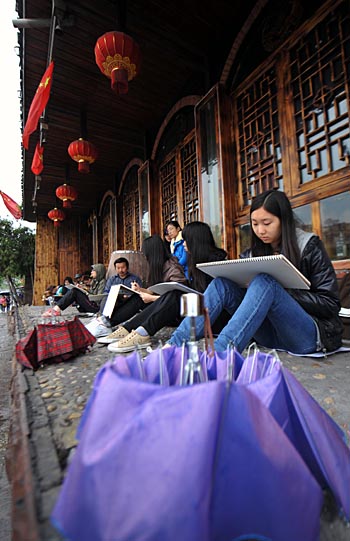|
 |
|
DRAW A SCENERY: Arts-major students from south China's Guangdong Province draw scenery at Fenghuang County in central China's Hunan Province on April 9 (XINHUA) |
As weather warms up, so does spring travel. And ticket prices for admission at popular attractions in China are following suit.
Visitors to Fenghuang County in central China's Hunan Province plummeted after the ancient town began to charge admission fees to see the hometown of writer Shen Congwen. Local businesses reported a sharp decrease in sales since the town set ticket prices at 148 yuan ($24) on April 10.
In addition, a recent report showed that a group of scenic spots in Jiangxi and Sichuan provinces have also raised admission prices. Wuyuan Scenic Spot in Jiangxi Province, for instance, went up 17 percent from 180 yuan ($29) to 210 yuan ($34). At Emei Mountain in southwest Sichuan Province, tickets during peak season rose 23 percent to 185 yuan ($30) from 150 yuan ($24).
The Dragon Cave Scenic Area in Zhangjiajie National Forest Park in Hunan Province went up 25 percent, increasing from 80 yuan ($13) to 100 yuan ($16). Admission prices in other tourist attractions in the province, such as the Baofeng Lake, located in the core area of Wulingyuan Scenic Area at Zhangjiajie, increased 30 percent from 74 yuan ($12) to 96 yuan ($15), and the Dehang Scenic Area tickets went up 67 percent from 60 yuan ($9.50) to 100 yuan ($16).
With soaring inflaton in recent years, admission ticket costs rose rapidly at certain scenic areas and historic attractions and tourism is again being regarded as a luxury few can afford.
Scenic areas in China's Hong Kong Special Administrative Region and Taipei of Taiwan Province were also swept into the rising tide of price hikes. Starting from March 27 this year, Hong Kong Disneyland raised its admission price from HK$399 ($51) per adult to HK$450 ($58). The general admission ticket price at the "National Palace Museum" in Taipei increased to NT250 ($8.37) from NT160 ($5.36), rising 56 percent.
In addition to the direct price rises, many scenic areas across the country have adopted a "one-ticket system" -- offering package deals that some accuse of being price hikes in disguise. Besides Fenghuang in Hunan Province, the Hangzhou Songcheng Scenic Area, a theme park that featuring architecture and lifestyle of the Song Dynasty (960-1279) in east China's Zhejiang Province, also launched a one-ticket promotion on April 10, with the price of 280 yuan ($45) per person, a rise of 20 yuan ($3).
However, the rising price of admission at scenic areas in China presents a striking constrast with its foreign counterparts.
For instance, all-day tickets to the Louvre, the largest national museum of France, is 11 euro ($14.50). The single entry fee for walking tours is only $12 at the Yellowstone National Park in the United States, according to the reports from theChina Securities Journalon April 1.
The reason for the unaffordable travel largely stems from the economic value of admission tickets, rather than the development of a tourism economy.
In fact, admission ticket prices account for only a small part of most tourists' overall consumption. Their money is mostly spent on food, accommodation, entertainment, shopping and transportation. Too heavy a focus on ticket revenue while ignoring other tourist spending is not worthwhile.
Tourism resources should value the public's benefit above local private gain. Attracting visitors relies on the creation of a sound tourism environment. Otherwise, travelers will be repelled by the high costs of admission.
The subsequent losses include not only the tourists themselves, but also related tourism spending. Which is most important? The tourism sector would do well to have a careful deliberation on the matter.
(Source: Overseas Edition of People's Daily) | 